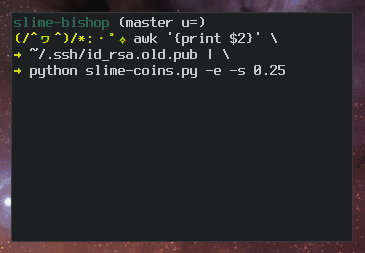Security at the expense of usability comes at the expense of security.
– AviD
Public key authentication is confusing, even for “professionals”. Part of the confusion is that base64-encoded public keys and private keys are just huge globs of meaningless letters and numbers. Even the hashed fingerprints of these keys are just slightly smaller meaningless globs of letters and numbers.
It is a known fact in psychology that people are slow and unreliable at processing or memorizing meaningless strings
– Hash Visualization: a New Technique to improve Real-World Security
Ensuring that two keys are the same means comparing key hashes— fingerprints. When using the md5 hash algorithm, comparing a key fingerprint means comparing 16, 16-bit numbers (and for the uninitiated that means blankly staring at 32 meaningless letters and numbers). In practice, that usually means not comparing 32 meaningless letters and numbers except when strictly necessary: Security at the expense of usability comes at the expense of security.
SSH Tricks ¶
I am constantly troubleshooting ssh. I spend a lot of time looking at the authlog and comparing keys.
I’ve learned some fun tricks that I use constantly:
- Get fingerprint from public key
ssh-keygen(1) ssh-keygen -l [-E md5] -f [public key]- Generate a public key given a private key
ssh-keygen(1) ssh-keygen -y -f [private key]- Automatically add server key to
known_hostsfilessh-keyscan(1): ssh-keyscan -H [hostname] >> ~/.ssh/known_hosts- List key fingerprints in ssh-agent
ssh-agent(1) ssh-add [-E md5] -l
When I get the message, Permission denied (publickey), I have a protocol.
- Find the fingerprint of the key being used by the authenticating host. This will either be in
ssh-agentor I may have to usessh-keygen -l -E md5 -f [publickey]on the authenticating host. - Find the
authorized_keysfile on the target machine:grep 'AuthorizedKeysFile' /etc/ssh/sshd_config - Compare the fingerprint of the public key from the authenticating host is among the fingerprints listed in the
authorized_keysfile.
Most ssh problems are caused by (SURPRISE!) the public key of the authenticating host not being present in the AuthorizedKeysFile on the target.
The Worm Bishop ¶
Most of the time when I “compare fingerprints” of keys, I copy, I paste, and finally I use the time-honored global regular expression print command. This is insecure behavior for myriad reasons. The secure way to compare keys is by manually comparing fingerprints, but meaningless string comparison is hard, which makes security hard, and, so, most folks simply aren’t secure. Security at the expense of usability comes at the expense of security.
In the release announcement for OpenSSH 5.1 a different approach to comparing fingerprints was announced:
Visual fingerprinnt [sic] display is controlled by a new ssh_config(5) option “VisualHostKey”. The intent is to render SSH host keys in a visual form that is amenable to easy recall and rejection of changed host keys.
The “VisualHostKey” is the source of the randomart ascii that you see if you add the -v flag to the ssh-keygen command from above:
$ ssh-keygen -lv -E md5 -f ~/.ssh/id_rsa.old.pub 2048 MD5:b2:c7:2a:77:84:3a:62:97:56:d0:95:49:63:fd:5d:2b tyler@tylercipriani.com (RSA) +---[RSA 2048]----+ | .++ | | .+.. .| | . . . . ..| | . . .E.. | | ...S . | | o+. | | +..o | | o B .o. | | . + +.. | +------[MD5]------+
This is something like an identicon for your ssh key:
Identicons’ intended applications are in helping users recognize or distinguish textual information units in context of many.
– Don Park
Although it is important to note that while the intent of an identicon is to distinguish against many, the intent of the VisualHostKey is more ambiguous.
The work to add this randomart was based on the paper Hash Visualization: a New Technique to improve Real-World Security, and the algorithm that generates these bits of art is discussed in detail in the paper The drunken bishop: An analysis of the OpenSSH fingerprint visualization algorithm. Also, interestingly, while the above paper contains a reference to the apocryphal drunken bishop leaving stacks of coins in each square he’s visited, the code comments in OpenSSH refer to a “worm crawling over a discrete plane leaving a trace […] everywhere it goes”.
Regardless of whether the algorithm’s protagonist is a worm or a bishop the story is similar. There is a discrete plane (or an atrium), the protagonist is in the middle (and possibly drunk), and moves around the room leaving a trail (either because they are slimy or because they are…drunk? and dropping coins because they’re drunk? I guess.), the more times they visit a particular part of the plane/atrium, the slimier/more-coin-filled it becomes. The direction of movement is determined by the little-endian processing of each word in the md5 checksum, so each run should create the same unique randomart for the same unique checksum.
I wrote a simple python version that visualizes the algorithm step-by-step which may be a better explainer than any meaningless strings I can group together:

ASCII Art is meaningless characters ¶
Confession time: I have never used randomart even when copying and pasting is impossible—I just compare strings. I have VisualHostKey yes in my ~/.ssh/config, but I almost never look at since OpenSSH warns me if a host-key has changed, so mostly it’s just taking up vertical space.
But why?
I think the reason I don’t use VisualHostKey to help distinguish between public-keys is that it failed to meet the regularity property of hash visualization:
Humans are good at identifying geometric objects (such as circles, rectangles, triangles, and lines), and shapes in general. We call images, which contain mostly recognizable shapes, regular images. If an image is not regular, i.e. does not contain identifiable objects or patterns, or is too chaotic (such as white noise), it is difficult for humans to compare or recall it.
– Hash Visualization: a New Technique to improve Real-World Security
Randomized ASCII art that is composed of common letters and frequently used symbols is very nearly the same as a string. The constituent parts are the same. This is the first problem: while Unicode contains symbols that are more recognizable, ASCII contains a very limited set of characters. This is a property that makes ASCII as an art-medium so charming, but makes abstract ASCII-art hard to remember as it fails to form geometric patterns that are easily distinguished from noise.
Secondly, ASCII randomart lacks any color, which is a property mentioned for hash visualizations as well as one of the more distinguishing features of identicons:
humans are very good at identifying geometrical shapes, patterns, and colors, and they can compare two images efficiently
– Hash Visualization: a New Technique to improve Real-World Security
Can I do better? ¶
No. Probably not if I had to work under the constraint that these hash visualizations need to work everywhere OpenSSH works. OpenSSH is an amazing piece of software and they are solving Hard™ problems while folks like me write blogs about ASCII art.
Donate to them now…I’ll wait.
For the purposes of differentiation, under the constraint that it must work on all terminals, I like the current solution. My liking the solution didn’t, of course, stop me from fiddling with the existing solution.
Add color ¶
The first stab I took at this was to add color. As an initial try I simply used the first 6 hex digits of the md5 checksum, converted those to rgb, and converted those to true-color ansi output:
def to_rgb(color):
return int(color[:2], 16), int(color[2:4], 16), int(color[4:], 16)
def to_ansi_rgb(color):
r, g, b = to_rgb(color)
return '\x1b[38;2;{};{};{}m'.format(r, g, b)This actually makes a huge difference in my ability to quickly differentiate between on key and another:
b2c72a77843a629756d0954963fd5d2b +-----------------+ | .++ | | .+.. .| | . . . . ..| | . . .E.. | | ...S . | | o+. | | +..o | | o B .o. | | . + +.. | +-----------------+
vs
161bc25962da8fed6d2f59922fb642aa +-----------------+ | o . | | = + | | . = o | | = + | | . S . | | o..o . | | o. o= | | . ..=.. | | E. o.+. | +-----------------+
Becomes purple-ish vs green, which is easy for me, but probably less easy for a sizable portion of the population. Further, while this solution works in terminals that support true-color output, I didn’t even take the time to make it fail gracefully to 8-bit color. Of course, with 8-bit color there are fewer means to differentiate via color. While color is visually distinctive to me, it is likely infeasible to implement, or unhelpful to a large portion of the population. Fair enough.
Different Charsets ¶
Unicode encodes some interesting characters to represent slime nowadays. There is the block element set, the drawing set, and even a micellaneous symbols set. I’m on linux so obviously some of these sets just look like empty boxes to me. But in my slime-bishop repo I did add support for a few symbols.
Oddly, I don’t think the symbols add too much to help differentiation.
b2c72a77843a629756d0954963fd5d2b +-----------------+ | ░▓▓ | | ░▓░░ ░| | ░ ░ ░ ░ ░░| | ░ ░ ░E░░ | | ░░░S ░ | | ▒▓░ | | ▓░░▒ | | ▒ ▆ ░▒░ | | ░ ▓ ▓░░ | +-----------------+
I think the problem of memory persists (sensible-chuckle.gif). We’re good at remembering regular pictures, but do abstract pictures count as regular?
Final thoughts ¶
Visual hash algorithms are a novel concept, and may become more useful over time. At the very least the ability to quickly reject that two keys match at a glance is a step in the right direction. The drunken bishop is certainly a fun algorithm to try to improve (while paying absolutely no attention to reasonable constrains like “terminal background color” or “POSIX compatibility”). The drunken slimy worm bishop, with their coins and/or their slime trails is certainly useful for differentiation (just like identicons), but it is not useful for identification. I hope that the distinction between differentiation and identification is clear for users of OpenSSH, but I’m not entirely sure that it is.
Improving the usability of security tooling is as important as it’s ever been; however, the corollary of, “security at the expense of usability comes at the expense of security.” is: usability that creates a false sense of security is at the expense of security. And we must remain mindful that we are not providing usability that is meaningless or (worse) usability that widens the attack surface without providing any real security benefit. Part of that comes from a shared understanding of the available features in the tools we already collectively use. In this way we can build on the work of one another, each bringing a unique perspective, and ultimately, maybe (just maybe) create tools that are usable and secure.
